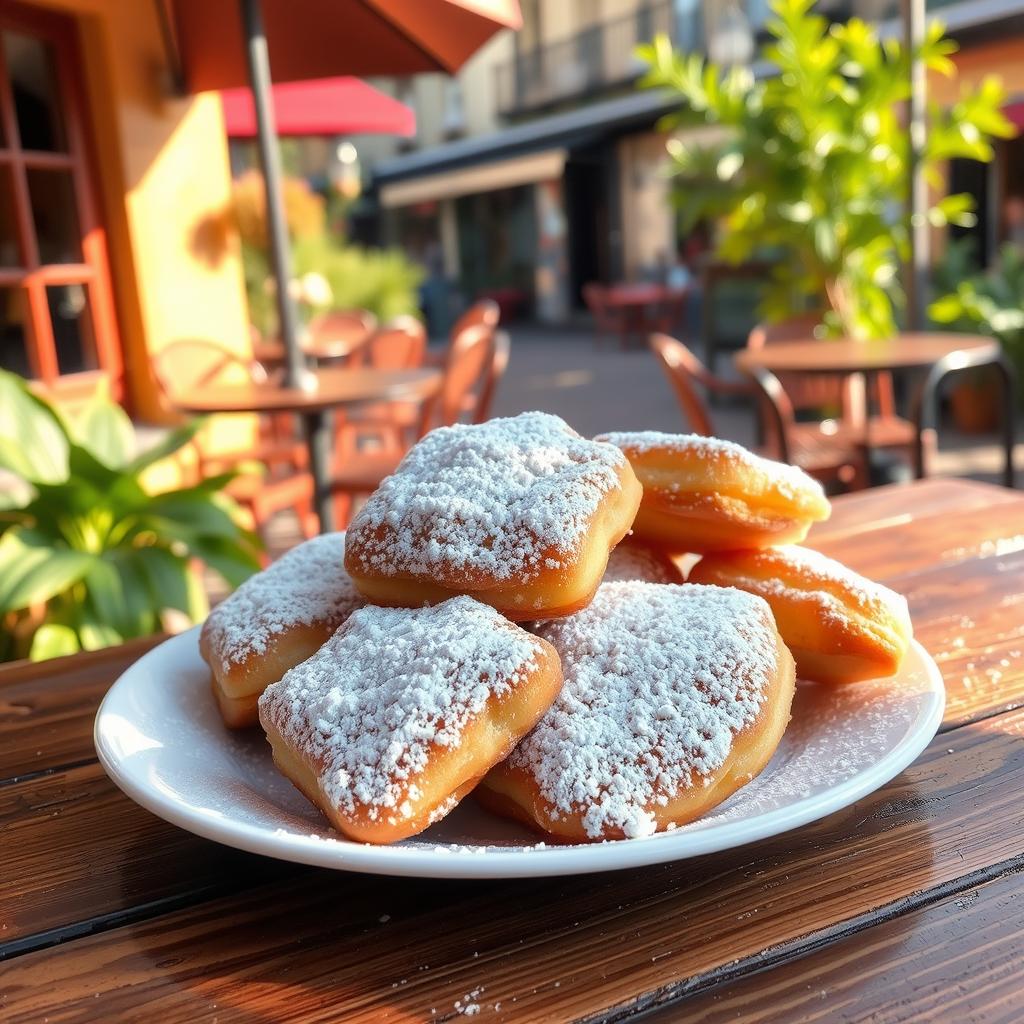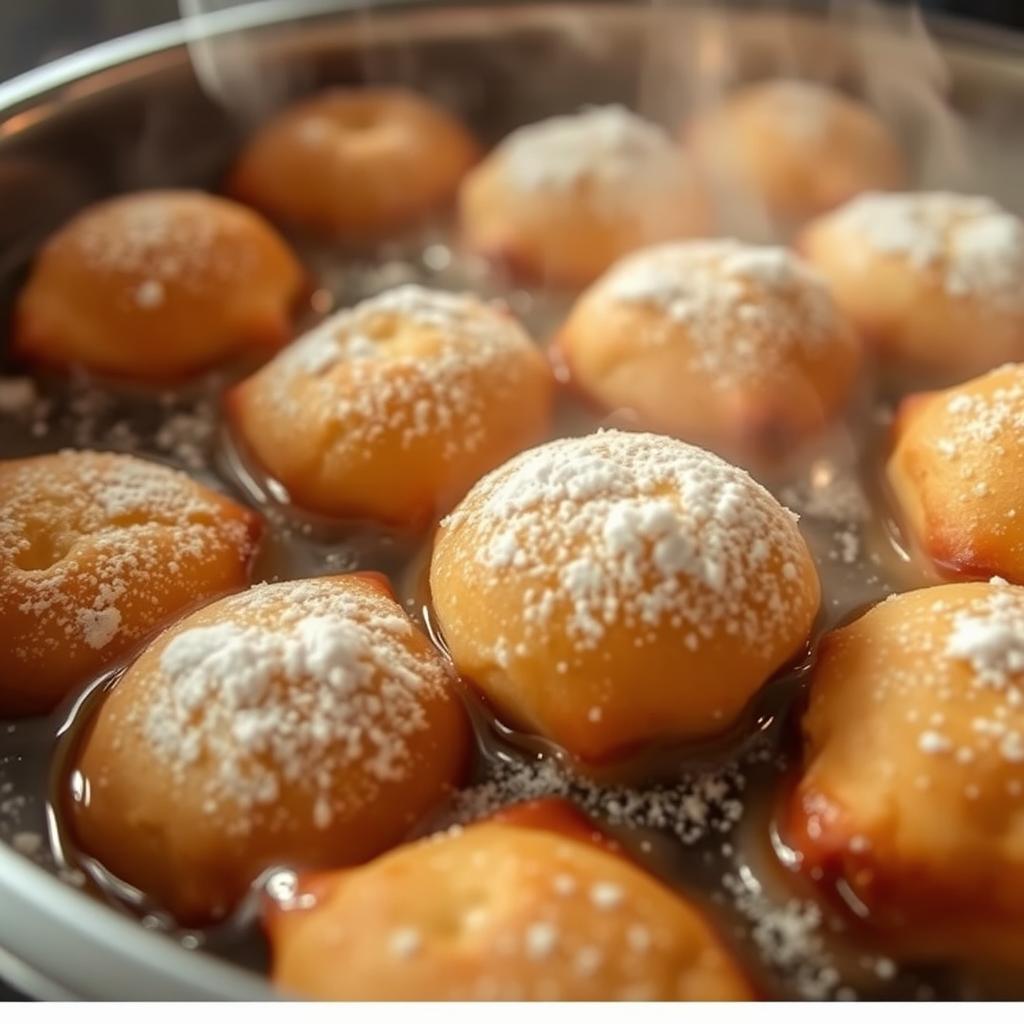The smell of fresh dough and sweet sugar fills the air. Walking through New Orleans, I feel like I’ve entered a world of French treats. Beignets, those square pastries, are a big part of the city’s food scene. They show off the city’s French roots and its welcoming vibe.

Key Takeaways
- Beignets are a signature French pastry from New Orleans, known for their light, pillowy texture and generous coating of powdered sugar.
- These deep-fried dough treats are a staple of Café du Monde, a renowned NOLA institution that has helped solidify their status as a must-try local delicacy.
- Beignets are traditionally served warm, often accompanied by a rich, aromatic cup of coffee, creating a quintessential New Orleans dining experience.
- The beignet dough requires a delicate balance of ingredients, including all-purpose flour, yeast, sugar, and dairy components, to achieve the perfect rise and texture.
- Proper frying technique and the generous application of powdered sugar are crucial in creating the signature beignet experience.
The History and Origins of Beignets
Beignets, the iconic square-shaped, fluffy pastries dusted with powdered sugar, have a rich heritage. This heritage is deeply rooted in the French colonial influence on New Orleans cuisine. These traditional pastries trace back to the 18th century, when French colonists first brought their culinary traditions to the city.
The origins of beignets are often debated. Some say they evolved from the French “Boules De Berlin,” a circular, cake-like fritter. But in New Orleans, the pastry took on a distinct square shape and a yeast-based dough. This transformation reflects the city’s unique cultural heritage and the ingenuity of its culinary pioneers.
Café du Monde Legacy
The legacy of beignets in New Orleans is closely tied to the iconic Café du Monde. Established in 1862, it has become synonymous with the city’s traditional pastry. This legendary establishment has played a crucial role in popularizing beignets. They are now an integral part of the New Orleans cuisine that visitors from around the world eagerly indulge in.
“Beignets are a fundamental part of the fabric of New Orleans, deeply intertwined with the city’s rich cultural heritage and the French colonial influences that have shaped its culinary identity.”
What Makes New Orleans Beignets with Powdered Sugar Special
New Orleans beignets are a local culinary icon. They are known for their unique texture and generous powdered sugar coating. These square-shaped doughnuts have a light, airy interior and a crisp exterior. This makes them a delightful treat that is quintessentially New Orleans flavor.
Unlike traditional donuts, beignets are made with a single-rise dough. This method gives them a pillowy, almost cloud-like interior. The generous dusting of powdered sugar adds a sweet contrast, making them a beloved New Orleans treat.
“Beignets are the essence of New Orleans – a perfect balance of textures and flavors that transport you to the heart of the French Quarter.”
The combination of a unique texture, powdered sugar coating, and New Orleans flavor makes these beignets a must-try. Whether at the iconic Café du Monde or a local spot, the experience is unforgettable.
Essential Ingredients for Perfect Beignets
Making the perfect New Orleans-style beignets needs a special mix of ingredients. At the core are all-purpose flour, active dry yeast, whole milk, granulated sugar, and powdered sugar. Each one is key to getting the beignets light, airy, and indulgent.
Flour and Yeast Selection
Choosing the right flour is important for beignets. All-purpose flour gives them the right mix of structure and lightness. Active dry yeast makes the dough rise, giving it a soft, pillowy texture.
Dairy Components
Whole milk and unsalted butter make beignets rich and tender. The milk adds moisture and a creamy feel. The butter boosts the flavor and texture.
Sugar Types and Uses
Granulated sugar and powdered sugar are both vital. Granulated sugar goes into the dough, adding sweetness and helping the yeast. Powdered sugar coats the fried beignets, giving them a classic white dusting.
“The perfect beignet is a harmonious blend of flour, yeast, dairy, and sugar – each element working in concert to create a truly indulgent and authentic experience.”
By picking and mixing these key ingredients, home bakers can make New Orleans-style beignets in their own kitchens.
The Difference Between Beignets and Traditional Donuts
Beignets and traditional donuts may look similar, but they are quite different. Beignets, famous in New Orleans, are square or rectangular. They differ from the usual ring-shaped donuts with holes.
The way they are made and served also varies. Beignets have a single rise, unlike donuts which rise twice. They are always served hot, covered in powdered sugar. Donuts, on the other hand, can be glazed, frosted, or served at room temperature.
| Feature | Beignets | Donuts |
|---|---|---|
| Shape | Square or rectangular | Ring-shaped with a hole |
| Dough Composition | Single rise | Double rise |
| Serving Style | Fresh, hot, and powdered sugar-coated | Glazed, frosted, or at room temperature |
Beignets and traditional donuts have their own charm. Whether you love the fluffy, square fritters of New Orleans or the classic ring-shaped donuts, both are delicious treats.

“Beignets are the official state doughnut of Louisiana, originating back in the 1760s when the Acadians arrived in the region.”
Step-by-Step Dough Preparation
Making perfect New Orleans-style beignets begins with a well-prepared dough. It’s important to achieve a light, airy texture. The dough should also be strong enough for frying without getting too dense or greasy.
Mixing and Kneading Techniques
Start by activating the yeast. In a medium bowl, mix 1 packet of active dry yeast with 3/4 cup of warm water (100°F-110°F) and 1/4 cup of granulated sugar. Wait 5-10 minutes for it to get frothy.
Then, in a large bowl, whisk together 1 beaten egg, 1/2 teaspoon of kosher salt, 1/2 cup of evaporated milk, and 1/8 cup of vegetable shortening. Add the yeast mixture and 3 1/2 cups of bread flour. Knead until the dough is smooth and pliable, either by hand or with a stand mixer.
Proofing Time and Temperature
After kneading, put the dough in a lightly greased bowl, cover it, and let it rise at room temperature for 1-2 hours. It should double in size. For even better flavor, refrigerate the dough for at least 3 hours or up to 24 hours.
Rolling and Cutting Methods
After proofing, punch down the dough to get rid of air bubbles. Roll it out to a 1/4-inch thickness on a lightly floured surface. Use a sharp knife or pizza cutter to cut it into 2-inch or 4-inch squares, as you like.
Now that the dough is ready, you can start frying and finishing to make those famous New Orleans beignets.
The Art of Frying Beignets
Frying beignets is an art that needs a gentle touch. These French-inspired treats must have a golden brown outside and a soft inside. The secret is keeping the oil temperature right and frying them for the right frying time.
The best oil temperature for frying beignets is between 325°F and 350°F. This ensures they cook evenly without burning. You can use cottonseed oil or other neutral oils like vegetable or canola.
- Fry the beignets in batches for 1.5 to 2 minutes on each side until they’re golden brown.
- Keep the heat steady to keep the oil at the perfect temperature.
- Use a slotted spoon or tongs to turn the beignets gently, without crowding the pan.
Getting the right texture is key for beignets. They should have a crisp outside and a soft inside. If they’re fried too hot, they might burn on the outside before cooking inside. If the oil is too cool, they’ll soak up too much oil and get greasy.
“The art of frying beignets is all about finding that perfect balance between the golden brown exterior and the fluffy, light interior. It’s a delicate dance, but with a little practice, you’ll be whipping up restaurant-worthy beignets in no time.”

By following these tips and adjusting the oil temperature and frying time as needed, you can become a pro at frying beignets. You’ll be able to make delicious New Orleans-style beignets in your own kitchen.
Mastering the Powdered Sugar Coating
The powdered sugar coating is key to the New Orleans beignet experience. These pastries are light, fluffy, and best enjoyed hot. A generous dusting of sweet powdered sugar is essential.
Getting the sugar coating just right is important. It’s what makes Cafe Du Monde’s beignets so famous.
Traditional Coating Techniques
There are a few ways to coat beignets in powdered sugar. The most common is to sift the sugar over the pastries. This method ensures an even powdered sugar application.
Another way is to toss the beignets in a bowl of powdered sugar. This generous coating method covers every part of the beignets in sweet powder.
Sugar-to-Beignet Ratio
The right amount of powdered sugar is crucial. For 18 beignets, use about 3 cups of sugar sifting. This adds a nice sweetness without overpowering the beignets.
| Beignet Quantity | Powdered Sugar Needed |
|---|---|
| 6 beignets | 1 cup |
| 12 beignets | 2 cups |
| 18 beignets | 3 cups |
| 24 beignets | 4 cups |
With the right amount of powdered sugar application, generous coating, and sugar sifting, you can make New Orleans beignets at home.
Traditional Serving Suggestions
Serving café au lait and flaky breakfast pastry is special in New Orleans. Beignets, those soft French doughnuts, are a big part of the city’s food scene. They’re perfect for breakfast or dessert.
At Café du Monde, you get three beignets covered in powdered sugar. It’s a sweet treat that shows off New Orleans’ rich history. The sugar and the warm doughnuts are a perfect mix.
Beignets go great with New Orleans coffee and steamed milk. This combo is called café au lait. The coffee’s strong flavor balances well with the soft beignets.
Looking for real New Orleans beignets? Try Café du Monde or smaller spots around town. They offer a taste of the city’s charm, morning or night. Beignets are a must-try for anyone visiting.
| Ingredient | Amount |
|---|---|
| Flour | 3 1/3 cups |
| Sugar | 1/4 cup |
| Instant Yeast | 2 teaspoons |
| Cardamom (optional) | 3/4 teaspoon |
| Milk | 1/2 cup |
| Water | 1/2 cup |
| Butter | 2 tablespoons |
| Egg | 1 large |
| Vanilla Extract | 1 teaspoon |
| Oil Depth for Frying | 3/4 inch |
| Oil Temperature for Frying | 360 to 370F (182 to 187C) |
| Powdered Sugar for Dusting | 1/8 cup for light dusting, or more for heavy dusting |
This table shows what you need to make perfect New Orleans beignets. It covers everything from flour and sugar to the right frying temperature. Follow these steps to make beignets just like the ones in New Orleans.
“Beignets, also known as ‘French donuts,’ can be enjoyed at Café Du Monde and other establishments in New Orleans.”
Beignets are a big part of New Orleans’ food history. They’re loved by locals and visitors. These soft, sugary treats are a must-try in the city.
Tips for Making Restaurant-Quality Beignets at Home
Making beignets at home like a pro is possible with the right steps. Focus on keeping the dough consistency and oil temperature control right. Also, use the freshest ingredients.
Common Mistakes to Avoid
One big mistake is overworking the dough. This makes beignets tough and dense. Another error is frying at the wrong temperature. If the oil is too hot, the outside gets dark fast while the inside stays raw.
Professional Baker’s Secrets
- Choose the freshest ingredients, like top-notch bread flour, active dry yeast, and the best dairy products.
- Let the dough proof for 8-12 hours. This ensures it rises well and has the right texture.
- Roll the dough to a 1/2-inch thickness with a rolling pin that has thickness guides.
- Keep the frying oil at 370-375°F. This way, the beignets cook evenly without burning.
- Fry the beignets in batches of 3-4. This prevents them from cooking unevenly.
- After frying, dust the beignets with 1/2 cup of powdered sugar for that classic New Orleans touch.
- Enjoy the beignets right away. They taste and feel best when they’re fresh.
By using these expert tips and avoiding common mistakes, you can make beignets that rival those from a restaurant. Your family and friends will love this delicious New Orleans treat.
| Prep Time | Cook Time | Total Time | Yield |
|---|---|---|---|
| 25 mins | 35 mins | 5 hrs | 5 dozen beignets |
Storage and Reheating Guidelines
Beignets are a favorite in New Orleans coffee shops. They taste best when fresh. But, you can still enjoy them a few days later with the right storage and reheating. This guide will help you keep them fresh or reheat them perfectly.
Short-Term Storage
Keep beignets in an airtight container at room temperature for up to 2 days. This keeps them soft and fresh. Don’t refrigerate them, as cold temperatures can ruin their freshness preservation.
Reheating Techniques
- Oven Reheating: Warm the beignets in a 350°F oven for 3-5 minutes. This brings back their crisp exterior and warm, fluffy interior.
- Microwave Reheating: For a quick reheat, microwave the beignets for 15-20 seconds. This method keeps them soft without losing their texture.
Always re-dust the reheated beignets with powdered sugar before serving. This keeps their classic New Orleans look and taste.
By using these storage and reheating guidelines, you can enjoy your New Orleans-style beignets for days. They’ll stay fresh and delicious, making every bite a joy.
Make-Ahead and Preparation Tips
For those who love to plan ahead, the beignet dough can be made up to 24 hours in advance. This overnight refrigeration method allows the flavors to develop, resulting in an even more delicious treat. When ready to fry, simply allow the dough to come to room temperature before rolling and cutting into the classic square shape.
Overnight Dough Method
Preparing the dough a day ahead not only saves time on the day of serving but also enhances the overall flavor of the beignets. The slow rise in the refrigerator helps develop the yeast’s aroma and creates a softer, more pillowy texture. Simply cover the dough tightly and refrigerate for up to 24 hours before using.
Batch Cooking Strategies
For those hosting a crowd or wanting to enjoy beignets throughout the week, batch cooking is the way to go. Make the dough in advance, then fry the beignets in small batches as needed. This ensures each serving is piping hot and freshly coated in powdered sugar, just like they’re served at the iconic Café du Monde in New Orleans.